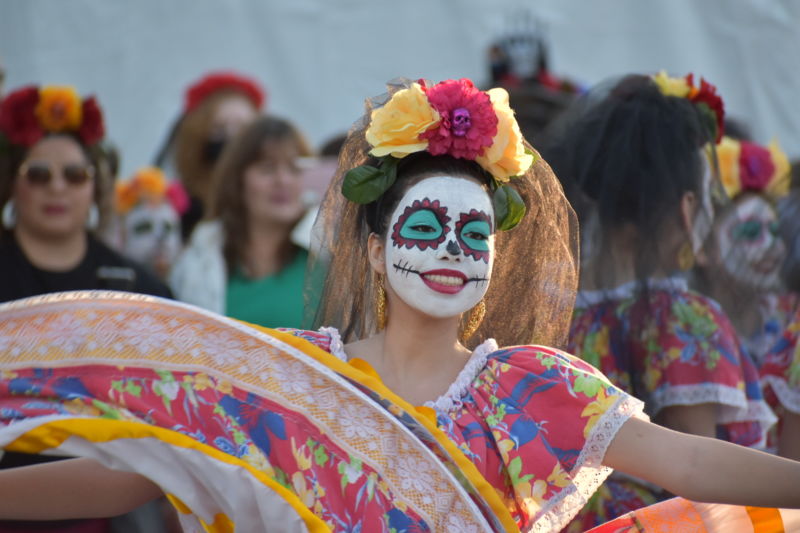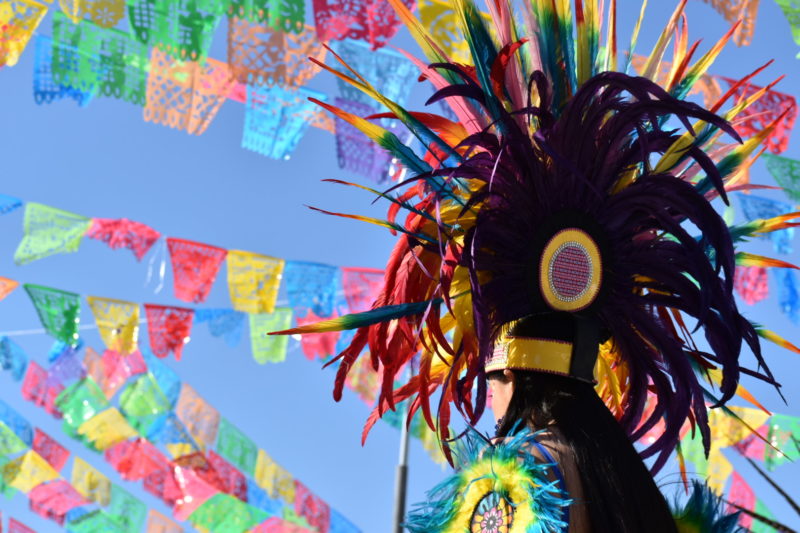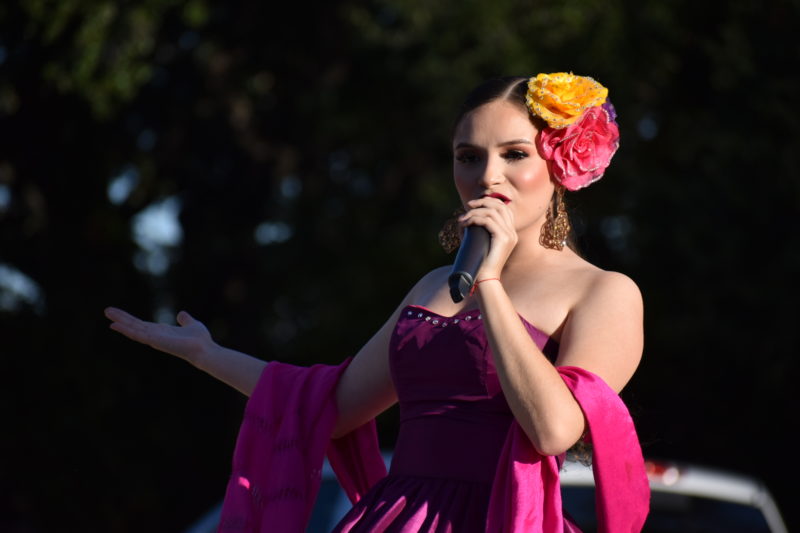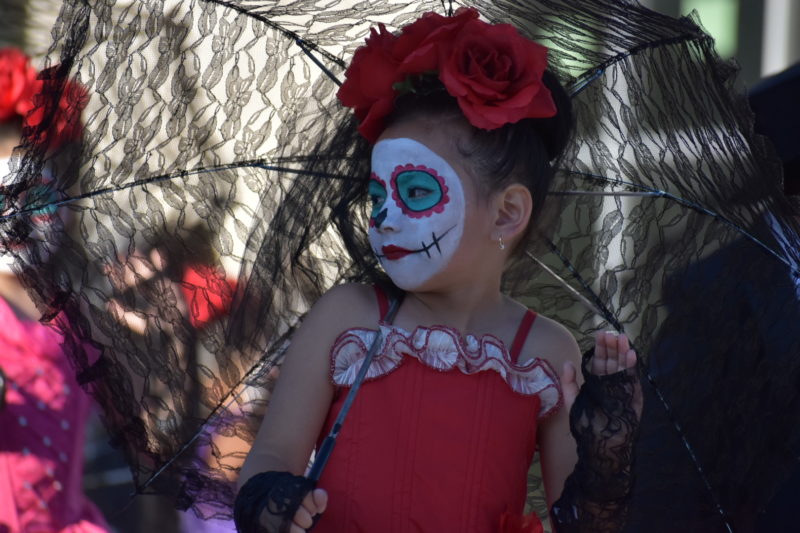Dia de los Muertos Provides Opportunity to Celebrate, Educate
By Taryn Courville
Photography By Taryn Courville
Reporting Texas

The scenery is a burst of color. Lines of patterned flags blow in the wind and paper marigolds decorate altars and hair. Performers walk around covered in face paint, dressed in traditional Mexican dresses or Aztec costumes. The sound of mariachi, drums and shell embellished ankle cuffs fills the area. Attendees of the Dia de los Muertos Festival and Procession in Round Rock and other annual events are fully immersed in the traditions of the holiday and Mexican culture.
Dia de los Muertos, or Day of the Dead, is a Mexican holiday dedicated to the celebration and remembrance of departed loved ones. Day of the Dead is celebrated over two days beginning at midnight on November 1. Traditionally, families create altars for their loved ones with pictures, foods, drinks and flowers and spend time at cemeteries. Symbols associated with the holiday include sugar skulls, marigolds and items for offering.
In Round Rock, Texas, the Dia de los Muertos Procession and Festival is an opportunity for Mexican families to celebrate the holiday as a community and for others to learn about and experience the tradition. Hosted by the city of Round Rock, Round Rock Ballet Folklorico and other city organizations, the event features local musicians, dance groups, face-painting, altars and a parade.
 Yolanda Sanchez, founder and executive director of Round Rock Ballet Folklorico, and her daughter, Selicia Sanchez-Adame, play a large role in organizing the procession and festival. The event in Round Rock came to be when Sanchez-Adame looked around and realized Dia de los Muertos was a big part of their culture that needed to be shared and celebrated in the community.
Yolanda Sanchez, founder and executive director of Round Rock Ballet Folklorico, and her daughter, Selicia Sanchez-Adame, play a large role in organizing the procession and festival. The event in Round Rock came to be when Sanchez-Adame looked around and realized Dia de los Muertos was a big part of their culture that needed to be shared and celebrated in the community.
“It’s something so much more than us. It’s about celebrating our loved ones, and if it wasn’t for all the hard work that everybody puts together, then we wouldn’t have this opportunity to embrace our culture,” Sanchez-Adame said.
Putting on the festival involves a lot of planning and coordination between groups, she said. While the event has been going on for eight years now, each year brings new difficulties. From lining up food vendors and performers, to making sure everyone has the right permits, to working with the city to close roads, she said “it’s kind of just making sure everybody has all their ducks in a row.”
For Sanchez, this event is an opportunity for her to ensure the culture and traditions of Dia de los Muertos continue to move on from generation to generation, she said. Despite the hours of planning and body aches involved with putting together the event, it’s worth it, she said.
“We all do it because of our culture. We do it because of our young people,” Sanchez said. “Will we do this again? In a heartbeat.”
Sanchez-Adame said she hopes to see the legacy of the event carry on for years to come, that the community is watching and being encouraged to be a part of continuing the festival and parade even after she and her mother are no longer involved.
“We’ve got to continue to push our heritage and understand it and not lose it. That’s the most important thing to us,” Sanchez-Adame said. “If you don’t know who you are, how can you move forward in life?”
One of the musicians, Alexandra Dorantes, performed twice at the festival. First playing violin for the group, Mariachi Classico, and later in the day singing in a solo performance.

Dorantes started playing violin classically at the age of 8 or 9 and joined a mariachi group in middle school. Her middle school mariachi group allowed Dorantes to practice her culture while playing music, and it is also where she began singing.
Through the pandemic, Dorantes hadn’t had as many opportunities to play, but even though she was nervous to get on stage at the festival, she said it was nice being able to perform in front of other people again. To her, Dia de los Muertos is a chance to celebrate life and those who have passed on. She said she xenjoyed the opportunity to share her music with others while participating in the traditions of the holiday.
“It’s something really intimate being able to perform at events like that,” Dorantes said.
Dia de los Muertos has become more popular in America as time goes on, to the point that decorations are appearing in stores like H-E-B, Target, Cracker Barrel and elsewhere. While there may be an element of commercialization, big stores carrying Day of the Dead décor is an opportunity for conversation and education, Sanchez-Adame said. It provides an opening for organizations with Mexican heritage to step forward and educate others on the meaning of the holiday.
 “When we first started this people thought it was a devil-worshiping event. They didn’t know any better,” Sanchez-Adame said. “Yes, it can be commercialized, but you know what, we’re going to walk hand in hand with you all to educate you on the meaning behind it.”
“When we first started this people thought it was a devil-worshiping event. They didn’t know any better,” Sanchez-Adame said. “Yes, it can be commercialized, but you know what, we’re going to walk hand in hand with you all to educate you on the meaning behind it.”
It would take a lot longer to educate so many people about Dia de los Muertos without its rise in popularity and presence in stores, she said. So, while more people are learning about the holiday, Sanchez-Adame and her mother are already looking ahead to next year.
“Every little bit of my body was in pain, and then I asked myself, ‘Are you ready for next year, Yolanda? Is this what you want to keep doing?’ ” Sanchez said. “And I answered, ‘Heck yes. All over again.’ ”